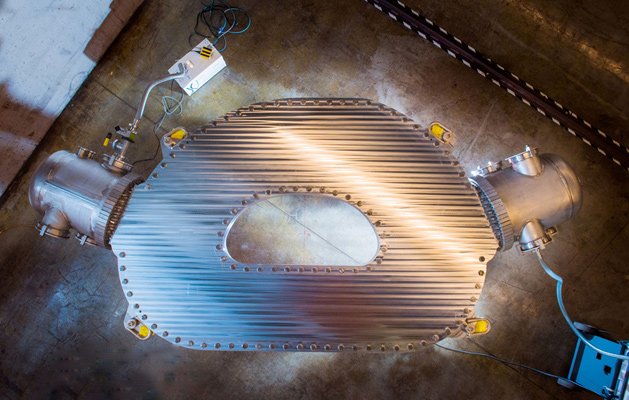MIT was particularly magnetic this past weekend

Magnetic tape for donut-shaped tokamak reactor. Photo by Gretchen Ertl, CFS/MIT-PSFC.
While most of us were enjoying the Labor Day weekend, researchers at MIT and a spin-off fusion company in Cambridge were powering up the world's most powerful version of a new type of superconducting magnet, one they say could help lead to fusion power actually becoming a reality.
On Sunday, researchers at MIT's Plasma Science and Fusion Center and colleagues from Commonwealth Fusion Systems turned on their "high-temperature superconducting electromagnet" in a nondescript brick building on Albany Street in Cambridge. MIT says they achieved a strength of 20 tesla, about 4,000 times stronger than the magnets that hold kid's pictures to a refrigerator - but more important, a new record for this type of magnet.
To achieve fusion - the creation of energy when two hydrogen atoms slam together to form a single helium atom - scientists have long tried to build chambers pulsing with strong magnetic fields to contain the super-hot plasma in which the atoms slam together, because the resulting temperatures, as high as 100 million degrees, would instantly melt any physical container.
Until a few years ago, this meant building copper-based magnet systems cooled to roughly 4 degrees above absolute zero - which is roughly -460 degrees F. At that temperature, copper becomes a superconductor - it can generate a much stronger magnetic field. One problem is that the stronger the field, the larger the required magnet system.
The MIT magnet, in contrast, is built around a type of tape that uses a new type of superconducting material that only needs to be cooled to roughly -420 degrees F. Still very cold, but enough of a difference that researchers can achieve the same sort of containment as earlier systems with far smaller magnet systems. According to MIT:
The new high-temperature superconductor material, made in the form of a flat, ribbon-like tape, makes it possible to achieve a higher magnetic field in a smaller device, equaling the performance that would be achieved in an apparatus 40 times larger in volume using conventional low-temperature superconducting magnets.
MIT adds:
With the magnet technology now successfully demonstrated, the MIT-CFS collaboration is on track to build the world’s first fusion device that can create and confine a plasma that produces more energy than it consumes. That demonstration device, called SPARC, is targeted for completion in 2025.
That reactor is being built at a Commonwealth Fusion site in Devens.
Ad:

Comments
Might there be a missing word?
My physics is a little rusty but do you need a "below" in there? :-)
"...absolute zero - which is roughly 460 degrees F..."
Adam is missing the negative
Adam is missing the negative sign. 4 Kelvin (which is the same scale, different baseline as Celsius) is -452 degrees F. It's cold. Really, really cold. It also usually requires the use of a lot of liquid helium, which is a finite resource, growing increasingly scarce and increasingly expensive to purchase.
Yep, missing the minus sign
Added.
One day MIT is going to open up a wormhole...
To another dimension. :o
Commercial fusion reactors
Are only 20 years away. Just as they have been for the past 50 years.